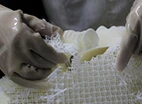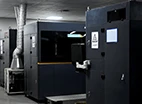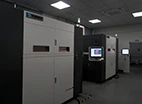
Made to order from 1 to 10,000 pieces on demand

One-on-one support service Response within 12 hours

In-house machine shop, 24/7 operations, Quick turnaround

Wide range of machining technicals. Tight tolerances, Finer surface finishes.

ISO 9001:2015 certified 100% part inspection




Our 3D Printing Services
IDEAL offers a wide range of in-house custom metal and plastic 3D printing services, enabling us to deliver printed parts in all forms, complexity, and size and fitted for different functions and applications. 3D printing can cost anywhere from a few dollars up to a hundred or thousands of dollars. The price depends on the material, printer, printing time, model complexity, and cost of labor. In manufacturing you're only as good as your last order, so we take quality seriously.
Once completed, your 3D printed parts are transferred to the quality control (QC) department for inspection. We include a comprehensive, standardized inspection report with every order to ensure quality metrics are being met.
3D Printing Processes We Are Offering
Stereolithography SLA
SLA is one of the original 3D printing technologies and one of the most versatile.
Our custom SLA Printing Service builds parts layer by layer from a photocurable resin. A high powered UV laser is focused onto the build platform to cure the material one layer at a time. SLA offers great accuracy and a good surface finish.
Typical accuracy: ± 0.2 mm
Typical Layer Heigh: 25 - 100μm
Selective Laser Sintering SLS
SLS is industrial quality 3D printing technology. Which builds accurate and durable parts from nylon (PA 12) materials. SLS is used extensively for prototypes and production parts. Similar to other 3D Printing technologies it builds parts layer by layer, from a powder material. Due to the versatile nature of powder based printing, SLS 3D printed parts are able to form complex shapes, without support structures.
Typical Accuracy: ± 0.3 mm
Typical Layer Heigh: 80 - 120 μm (most common: 100 μm)
Fused Deposition Modelling FDM
FDM 3D Printing is one of the more common 3D printing technologies and also one of the most versatile. FDM builds parts by extruding plastic filament material through a nozzle and laying it down on the build chamber one layer at a time. FDM can realise complex geometries but due to the restrictions of the process any overhanging features will require support material which needs to be removed post process.
Due to the range of material options FDM is a great choice for quick prototype and low volume production.
Typical Accuracy: ±0.5 mm
Typical Layer Heigh: 50 - 400 μm (most common: 200 μm)
Direct Metal Laser Sintering DMLS
DMLS is an industrial 3D printing technology, which builds parts from a range of metal materials one layer at a time – by carefully sintering metal based powders together. This process is capable of building highly complex shapes, which would be almost impossible to make via other 3D printing methods. The difference between DMLS (Direct Metal Laser Sintering) and SLS (Selective Laser Sintering) is the type of materials that can be used to print the required parts.
Typical Accuracy: ±0.1mm
Typical Layer Height: 30 - 50 μm
Advantages of 3D Printing
Affordability
Since 3D printing uses only the required material and needs no tooling, it is one of the most affordable manufacturing processes for one-off parts or small batches.
Geometries
Strong 3D printers create parts layer by layer using a computer-controlled nozzle, they can be used to create highly complex shapes, including complex interior geometries.
Efficiency
Once a part has been designed using CAD software, it can be printed in a matter of hours, without a lengthy setup procedure.
Adaptability
Because 3D printed parts require no tooling, there is less risk involved when creating a part. If a fault is discovered after printing, it can be amended digitally without the need to replace expensive tooling.
Environmental factors
Although 3D printers require power to operate, there is generally no material wastage involved. Subtractive processes like machining, on the other hand, produce waste material.
Comparison of our 3D Printing Capabilities
| SLS | SLA | FDM | DMLS | |
| Leading Time | 3 Days | 3 Days | 7 Days | 5 Days |
| Build Volume | 400*400*450 mm | 800*800*550 mm | 750*750*750 mm | 280×280×280 mm |
Layer Thickness | 0.1 mm to 0.2 mm (specific layer thickness can depend on the machine and material) | 0.025 mm to 0.1 mm | 0.1 mm to 0.3 m, some printers can go as low as 0.05 mm for higher detail. | 0.02 mm to 0.1 mm (specific layer thickness can depend on the machine and material) |
Min Feature Size | 0.5 mm | 0.2 mm | up to 0.2mm | 0.75 mm for cosmetic features, 1.5 mm for structural |
Tolerance | Approximately ±0.1 mm to ±0.3 mm for most parts. | Approximately ±0.1 mm to ±0.2 mm for most parts. | Approximately ±0.2 mm to ±0.5 mm for most parts. | Standard Parts: Approximately ±0.1 mm to ±0.3 mm (100 to 300 microns). Complex or Large Parts: Can be as much as ±0.5 mm (500 microns), depending on the design and printing parameters. |
| Description | One of the most popular and inexpensive technologies for industrial 3D printing | A technology that produces extremely accurate and high-resolution parts | Widely known for a great material selection, accuracy, and possibility to print large parts | Selectively fuses a fine metal powderin aluminium or stainless steel |
Support Structures | NO | Yes, for overhanging features | Yes, for overhanging features | Yes, for overhanging features |
| Prototyping Applications | Functional prototypes for testing or usability trials. | Highly detailed visual prototypes. | Proof-of-concept prototypes from a wide range of materials. | Metal prototypes with complex geometries. |
What Materials Can lDEAL Provide For 3D Printing?
SLA Materials available at IDEAL: Standard ABS-Like SLA resins, Clear resins and Engineering SLA resins.
FDM Materials available at IDEAL: PLA, ABS, Nylon, IPE/TPU, PC.
DMLS Materials available at IDEAL: Titanium, Aluminum alloys (AlSi12 and AlSi10Mg), Cobalt, Nickel.
SLS Materials available at IDEAL: PA12, PA12 Glass Filled.
IDEAL offers a comprehensive range of additive manufacturing solutions for all applications, from one-offs rapid prototypes, batch quantities to intricate functional parts and higher-scale production. Our rapid 3D printing services, enables you to produce parts faster and more cost-efficiently, speed up your innovation cycle and time to market.
How 3D Printing Works?
The printing process of 3D printing involves several key steps that transform a digital design into a physical object. Here's a detailed breakdown of the 3D printing process:
Slicing
Slicing Software: Use slicing software to convert the 3D model into a series of 2D cross-sectional layers. The software breaks the model down into horizontal slices and generates the G-code, which is a set of instructions for the 3D printer.
Settings Adjustment: Configure printing parameters, including layer height, print speed, infill density, and support structures, based on the desired quality and functionality of the final object.
Cooling and Solidification
Cooling: Depending on the technology used, the printed layers may need time to cool or cure. For FDM, the material cools rapidly, while SLA, SLS and DMLSmay require additional curing or cooling time.
Printer Setup
Material Loading: Load the appropriate printing material into the 3D printer. This could be filament (for FDM printers), resin (for SLA printers), or powder (for SLS printers).
Printer Calibration: Calibrate the printer to ensure accurate printing. This may include leveling the print bed and adjusting nozzle height.
Printing Process
Layer-by-Layer Construction: The printer follows the G-code instructions to build the object layer by layer:
Fused Deposition Modeling (FDM): oA thermoplastic filament is heated and extruded through a nozzle, depositing melted plastic onto the print bed in thin layers.
Stereolithography (SLA): A UV laser cures liquid resin layer by layer. The laser solidifies the resin according to the model's cross-section.
Selective Laser Sintering (SLS) & Direct Metal Laser Sintering (DMLS): A laser fuses powdered material together, building the object layer by layer as the powder bed is lowered after each layer is fused.
Post-Processing and Final Inspection
Material Loading: If the model requires supports, these are removed after printing.
Finishing Touches: Additional steps may include sanding, painting, or applying surface treatments to improve aesthetics or functionality.
Curing (for SLA): If using SLA, the printed object may need to be cured under UV light to ensure full hardness.
Quality Control: Inspect the finished product for quality and accuracy. Check for any defects or imperfections.
Choose The Right 3D Printing Service
Advantages and Disadvantages of FDM/ SLA/ SLS/ DMLS
| Technology | Advantages | Disadvantages |
| FDM | Low cost,easy to use,wide range of materials Cost-effective &Material Variety Widely Available &User-friendly Support Structures Eco-Friendly | Lower Print Resolution Visible Layer Lines Limited Dimensional Accuracy Post-processing Requirements |
| SLA | High Precision and Accuracy Excellent Surface Finish Automatically Generate Support Structures Fast Printing Speed High Resolution | Limited range of materials Limited Print Size Higher Equipment and Material Cost Limited Heat Resistance Require Post-processing Steps After Printing Support Structure Removal Longer Print Times |
| SLS | Complex Geometries No Printing Support Required Excellent Mechanical Properties Cost-effective for Low-Volume Production Time-Efficient Can Produce Functional Prototypes Reduced Material Waste | Higher Equipment and Operation Costs Limited Print Size Post-Processing Requirements Material Limitations Have a Slightly Rougher Surface Finish Heat Sensitivity Lack of Color Options Produces More Powder Dust Lower heat energy requirement.Sintering temperature ranges from 160°C-200°C |
| DMLS | Highest precision Durable metal parts Wide Range of Metals Production of Strong Functional Parts in complex geometries (154μ) | Complex installation Requires Printing Support High Printing Costs Slow Printing Speed and Smaller Print Volume Various post-processing activities (like heat treatment,surface finishing,machining,de-powdering,and part unloading) More than 80%of unsintered powder cannot be recycled High energy requirement.Uses a high-voltage laser with melting temperatures ranging from 1,510°C - 1,600°C Demanding in terms of cooling time and post-processing |
Have any Questions or Suggestions? We would love to help you! Talk to us!
Overview of 3D Printing Post-Processing Solutions
Sanding and Polishing: Smooths surfaces for better finish and fit.
Chemical Smoothing: Uses solvents to achieve a glossy, smooth surface.
Painting and Coating: Applies color or protective layers to enhance appearance and durability.
Heat Treatment: Strengthens printed parts by reducing internal stresses, often used with metal or high-performance polymers.
Assembly and Bonding: Joins multiple printed parts, essential for complex or large structures.
3D Printing FAQs
Q: What Are The Common Applications Of 3D Printing?
A:
3D printing is used in various fields, including:
● Prototyping: Rapidly creating prototypes for product development.
● Manufacturing: Producing end-use parts and tooling.
● Medical: Custom prosthetics, implants, and dental products.
● Aerospace: Lightweight components and tooling.
● Art and Design: Creating sculptures, jewelry, and intricate designs.
Q: What Are The Limitations Of 3D Printing?
A:
Some limitations include:
● Material Properties: Not all materials offer the same strength or durability as traditionally manufactured parts.
● Surface Finish: Some methods may require post-processing to achieve a smooth finish.
● Size Constraints: The maximum size of printed parts is limited by the printer's build volume.
● Printing Speed: Depending on complexity, printing can be slower than traditional manufacturing methods for large volumes.
Q: Do I Need To Do Post-Processing After 3D Printing Processing?
A:
Post-processing is often required to achieve the desired finish and performance. Common post-processing techniques include:
● Sanding and polishing: To improve surface finish.
● Painting: For aesthetics and protection.
● Assembly: For multi-part prints that need to be joined.
● Curing: Especially for SLA prints to enhance strength and stability.
Q: Can I 3D Print Large Objects?
A:
Yes, but it depends on the printer's build volume. Large objects may require a printer with a bigger build plate or could be printed in sections and assembled later.
Q: How Do I Choose The Right 3D Printing Technology?
A:
Choosing the right technology depends on factors such as:
● Project requirements: Consider size, detail, and mechanical properties needed.
● Material options: Select based on desired characteristics (e.g., flexibility, strength).
● Production volume: For prototyping, FDM might be suitable, while for small batches, SLA or SLS could be better.
● Budget: Different technologies have varying costs associated with materials and equipment.
3D Printing Cases
Our clients include Medical & Scientific research agencies to Military, Civilian and consumer enterprises.
See What Our Custom Say

My experience working with Fay was great.Clear communication that put me at ease. Very easy to order these parts. Great quality and werecieved exactly what we were expecting - Followed the engineered drawings precisely. Theproduct arrived well packaged, and precisely to spec.
Thank you very much for your consideration and problem solving. lt says a lot about your companyand 1feel comfortable working with you moving forward.
Chris
R&D Manager

IDEAL was able to deliver an accurate and quick service for high quality CNC parts. We inspected the parts, everything was within tolerance in terms of dimensions, and the surface finish on the machined faces is really good. IDEAL has always given us exactly what we needed.
Dennis J.
Engineer

Partnering with IDEAL has transformed our production process. Their precision, reliability, and commitment toquality have been game-changers for us. We've seen a remarkable improvement in efficiency and productquality, allowing us to meet our customers' demands better than ever. IDEAL's team truly understands oulneeds and consistently delivers beyond our expectations.
Jennie Elp.
Senior Mechanical Designer
Latest News
3D Printing: Process, Pros & Cons, and Applications
Feb. 21, 2025
3D printing, also known as additive manufacturing, is a process of creating three-dimensional objects by adding material layer by layer, based on a digital model. Unlike traditional manufacturing methods, which often involve subtracting material (like cutting or milling), 3D printing builds objects up from scratch, which allows for more complex and
Get Your Parts Into Production Today!
Meeting Your Needs, Solving Your Problems - We're Here to Make CNC Machining Hassle-Free!
GET IN TOUCH WITH US
Navigation
RESOURCE
Contact Us
Tel: 0755-36957776
E-mail: info@idealrp.com
Skype: +86 135 2877 3620
Whatsapp: +86 135 2877 3620
Add.: Shenghua Building, Songgang, Bao'an,Shenzhen 518105
Add.: Room 4, 16/F, Ho King Commercial Building, 2-16 Fa Yuen Street, Mong Kok, Kowloon, Hong Kong

















